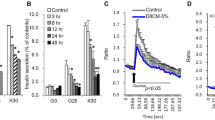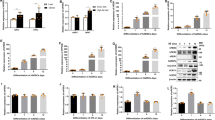Abstract
Context:
Obesity is associated with hypersecretion of cortisol and aldosterone and a high prevalence of arterial hypertension. At the cellular level, a direct effect of adipocytes on the expression of the steroidogenic acute regulatory (StAR) protein, a regulator of cortisol and aldosterone synthesis, and on aldosterone and cortisol secretion has been shown. However, the molecular mechanisms mediating this effect are not known.
Objective:
Wnt-signaling molecules are secreted by adipocytes and regulate the activity of SF-1, a key transcription factor in adrenal steroidogenesis. Therefore, we investigated whether adipocytes stimulate adrenal steroidogenesis through the activation of Wnt-signaling.
Results:
Using immunohistochemistry, we detected the expression of frizzled and β-catenin in the adult human adrenal cortex. Transient transfection of a Wnt-dependent reporter-gene into adrenal NCI-H295R cells showed an induction of Wnt-mediated transcription to 308% after treatment with human fat cell-conditioned medium (FCCM). This finding was paralleled by an induction of StAR promoter activity (420%) by FCCM. The induction of StAR promoter activity by FCCM was inhibited by 49% when Wnt-signaling was blocked by the soluble Wnt-antagonist secreted Frizzled-Related-Protein-1 (sFRP-1). Overexpression of a constitutively active mutant of β-catenin induced the transcription of the StAR promoter (440%). β-Catenin and FCCM induced SF-1-mediated transcription at a SF-1-driven reporter gene (420 and 402%, respectively). Furthermore, the secretion of aldosterone and cortisol by NCI-H295R cells induced by FCCM was significantly inhibited by the Wnt-antagonist sFRP-1.
Conclusion:
These data indicate that the Wnt-signaling pathway is one of the mechanisms mediating the effects of fat cells on adrenal StAR transcription and aldosterone and cortisol secretion.
This is a preview of subscription content, access via your institution
Access options
Subscribe to this journal
Receive 12 print issues and online access
$259.00 per year
only $21.58 per issue
Buy this article
- Purchase on Springer Link
- Instant access to full article PDF
Prices may be subject to local taxes which are calculated during checkout





Similar content being viewed by others
References
Dalton M, Cameron AJ, Zimmet PZ, Shaw JE, Jolley D, Dunstan DW et al. Waist circumference, waist-hip ratio and body mass index and their correlation with cardiovascular disease risk factors in Australian adults. J Intern Med 2003; 254: 555–563.
Goodfriend TL, Egan BM, Kelley DE . Aldosterone in obesity. Endocr Res 1998; 24: 789–796.
Goodfriend TL, Kelley DE, Goodpaster BH, Winters SJ . Visceral obesity and insulin resistance are associated with plasma aldosterone levels in women. Obes Res 1999; 7: 355–362.
Goodfriend TL, Egan BM, Kelley DE . Plasma aldosterone, plasma lipoproteins, obesity and insulin resistance in humans. Prostaglandins Leukot Essent Fatty Acids 1999; 60: 401–405.
Rocchini AP, Key J, Bondie D, Chico R, Moorehead C, Katch V et al. The effect of weight loss on the sensitivity of blood pressure to sodium in obese adolescents. N Engl J Med 1989; 321: 580–585.
Lamounier-Zepter V, Bornstein SR, Ehrhart-Bornstein M . Mechanisms of obesity-related hypertension. Hormone Metab Res 2004; 36: 376–380.
Kelly JJ, Mangos G, Williamson PM, Whitworth JA . Cortisol and hypertension. Clin Exp Pharmacol Physiol Suppl 1998; 25: S51–S56.
Yanovski JA, Yanovski SZ, Gold PW, Chrousos GP . Differences in corticotropin-releasing hormone-stimulated adrenocorticotropin and cortisol before and after weight loss. J Clin Endocrinol Metab 1997; 82: 1874–1878.
de Paula RB, da Silva AA, Hall JE . Aldosterone antagonism attenuates obesity-induced hypertension and glomerular hyperfiltration. Hypertension 2004; 43: 41–47.
Ehrhart-Bornstein M, Lamounier-Zepter V, Schraven A, Langenbach J, Willenberg HS, Barthel A et al. Human adipocytes secrete mineralocorticoid-releasing factors. Proc Natl Acad Sci USA 2003; 100: 14211–14216.
Bays H, Mandarino L, DeFronzo RA . Role of the adipocyte, free fatty acids, and ectopic fat in pathogenesis of type 2 diabetes mellitus: peroxisomal proliferator-activated receptor agonists provide a rational therapeutic approach. J Clin Endocrinol Metab 2004; 89: 463–478.
Ross SE, Hemati N, Longo KA, Bennett CN, Lucas PC, Erickson RL et al. Inhibition of adipogenesis by Wnt signaling. Science 2000; 289: 950–953.
Longo KA, Kennell JA, Ochocinska MJ, Ross SE, Wright WS, MacDougald OA . Wnt signaling protects 3T3-L1 preadipocytes from apoptosis through induction of insulin-like growth factors. J Biol Chem 2002; 277: 38239–38244.
Logan CY, Nusse R . The Wnt signaling pathway in development and disease. Annu Rev Cell Dev Biol 2004; 20: 781–810.
Gummow BM, Winnay JN, Hammer GD . Convergence of Wnt signaling and steroidogenic factor-1 (SF-1) on transcription of the rat inhibin alpha gene. J Biol Chem 2003; 278: 26572–26579.
Hossain A, Saunders GF . Synergistic cooperation between the beta-catenin signaling pathway and steroidogenic factor 1 in the activation of the Mullerian inhibiting substance type II receptor. J Biol Chem 2003; 278: 26511–26516.
Jordan BK, Shen JH, Olaso R, Ingraham HA, Vilain E . Wnt4 overexpression disrupts normal testicular vasculature and inhibits testosterone synthesis by repressing steroidogenic factor 1/beta-catenin synergy. Proc Natl Acad Sci USA 2003; 100: 10866–10871.
Val P, Lefrancois-Martinez AM, Veyssiere G, Martinez A . SF-1 a key player in the development and differentiation of steroidogenic tissues. Nucl Recept 2003; 1: 8.
Stocco DM, Wang X, Jo Y, Manna PR . Multiple signaling pathways regulating steroidogenesis and steroidogenic acute regulatory protein expression: more complicated than we thought. Mol Endocrinol 2005; 19: 2647–2659.
Hagen T, Sethi JK, Foxwell N, Vidal-Puig A . Signalling activity of beta-catenin targeted to different subcellular compartments. Biochem J 2004; 379 (Part 2): 471–477.
Lala DS, Syka PM, Lazarchik SB, Mangelsdorf DJ, Parker KL, Heyman RA . Activation of the orphan nuclear receptor steroidogenic factor 1 by oxysterols. Proc Natl Acad Sci USA 1997; 94: 4895–4900.
Caron KM, Ikeda Y, Soo SC, Stocco DM, Parker KL, Clark BJ . Characterization of the promoter region of the mouse gene encoding the steroidogenic acute regulatory protein. Mol Endocrinol 1997; 11: 138–147.
Rainey WE, Bird IM, Mason JI . The NCI-H295 cell line: a pluripotent model for human adrenocortical studies. Mol Cell Endocrinol 1994; 100: 45–50.
Gazdar AF, Oie HK, Shackleton CH, Chen TR, Triche TJ, Myers CE et al. Establishment and characterization of a human adrenocortical carcinoma cell line that expresses multiple pathways of steroid biosynthesis. Cancer Res 1990; 50: 5488–5496.
Schinner S, Barthel A, Dellas C, Grzeskowiak R, Sharma SK, Oetjen E et al. Protein kinase B activity is sufficient to mimic the effect of insulin on glucagon gene transcription. J Biol Chem 2005; 280: 7369–7376.
Suwa T, Chen M, Hawks CL, Hornsby PJ . Zonal expression of dickkopf-3 and components of the Wnt signalling pathways in the human adrenal cortex. J Endocrinol 2003; 178: 149–158.
Eckel RH, Grundy SM, Zimmet PZ . The metabolic syndrome. Lancet 2005; 365: 1415–1428.
Kopelman PG . Obesity as a medical problem. Nature 2000; 404: 635–643.
Egan BM, Stepniakowski K, Goodfriend TL . Renin and aldosterone are higher and the hyperinsulinemic effect of salt restriction greater in subjects with risk factors clustering. Am J Hypertens 1994; 7 (10 Part 1): 886–893.
Licata G, Scaglione R, Ganguzza A, Corrao S, Donatelli M, Parrinello G et al. Central obesity and hypertension. Relationship between fasting serum insulin, plasma renin activity, and diastolic blood pressure in young obese subjects. Am J Hypertens 1994; 7 (4 Part 1): 314–320.
Zhang Y, Proenca R, Maffei M, Barone M, Leopold L, Friedman JM . Positional cloning of the mouse obese gene and its human homologue. Nature 1994; 372: 425–432.
Kahn BB, Flier JS . Obesity and insulin resistance. J Clin Invest 2000; 106: 473–481.
Hammer GD, Parker KL, Schimmer BP . Minireview: transcriptional regulation of adrenocortical development. Endocrinology 2005; 146: 1018–1024.
Heikkila M, Peltoketo H, Leppaluoto J, Ilves M, Vuolteenaho O, Vainio S . Wnt-4 deficiency alters mouse adrenal cortex function, reducing aldosterone production. Endocrinology 2002; 143: 4358–4365.
Fujino T, Asaba H, Kang MJ, Ikeda Y, Sone H, Takada S et al. Low-density lipoprotein receptor-related protein 5 (LRP5) is essential for normal cholesterol metabolism and glucose-induced insulin secretion. Proc Natl Acad Sci USA 2003; 100: 229–234.
Tian E, Zhan F, Walker R, Rasmussen E, Ma Y, Barlogie B et al. The role of the Wnt-signaling antagonist DKK1 in the development of osteolytic lesions in multiple myeloma. N Engl J Med 2003; 349: 2483–2494.
Berndt T, Craig TA, Bowe AE, Vassiliadis J, Reczek D, Finnegan R et al. Secreted frizzled-related protein 4 is a potent tumor-derived phosphaturic agent. J Clin Invest 2003; 112: 785–794.
Acknowledgements
The β-catenin expression vector (β-cat S45A) has been provided by Dr Thilo Hagen (Wolfson Digestive Diseases Centre, University of Nottingham, UK). The plasmids for -65-Luc, pSF-1 and –966Luc (StAR Promoter) were generous gifts from Dr KL Parker (South-western Medical Center, University of Texas, Dallas, USA) and Dr D Stocco (Texas Tech University, Lubbock, USA), respectively. This work was supported by a grant from the Eberhard-Igler-Stiftung and Walter-Clawitter-Stiftung to S Schinner and HS Willenberg and by a grant from the Deutsche Forschungsgemeinschaft (EH 161/4-1) to M Ehrhart-Bornstein and SR Bornstein.
Author information
Authors and Affiliations
Corresponding author
Rights and permissions
About this article
Cite this article
Schinner, S., Willenberg, H., Krause, D. et al. Adipocyte-derived products induce the transcription of the StAR promoter and stimulate aldosterone and cortisol secretion from adrenocortical cells through the Wnt-signaling pathway. Int J Obes 31, 864–870 (2007). https://doi.org/10.1038/sj.ijo.0803508
Received:
Revised:
Accepted:
Published:
Issue Date:
DOI: https://doi.org/10.1038/sj.ijo.0803508
Keywords
This article is cited by
-
Molecular Mechanisms of Sodium-Sensitive Hypertension in the Metabolic Syndrome
Current Hypertension Reports (2017)
-
Genomic and rapid effects of aldosterone: what we know and do not know thus far
Heart Failure Reviews (2017)
-
Aldosterone Production and Signaling Dysregulation in Obesity
Current Hypertension Reports (2016)
-
Changes in morphology and function of adrenal cortex in mice fed a high-fat diet
International Journal of Obesity (2015)
-
Treatment of Hypertension in Obese Patients
American Journal of Cardiovascular Drugs (2013)



